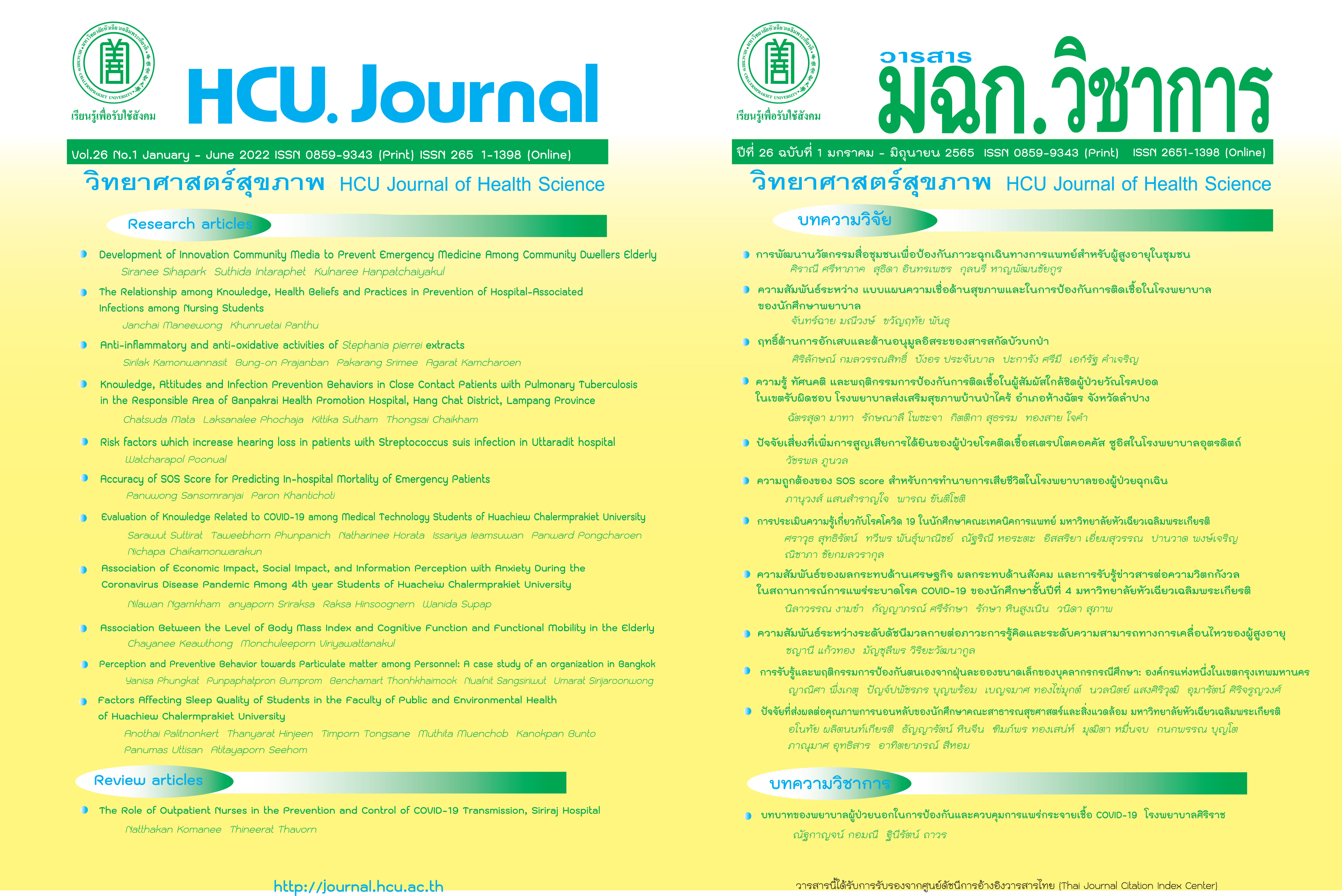Anti-inflammatory and anti-oxidative activities of Stephania pierrei extracts
Keywords:
Stephania pierrei Diels, sodium starch glycolate, Anti-inflammatory activity, Cytotoxicity, Pro-inflammatory mediatorsAbstract
A tuber of Stephania pierrei Diels (Menispermaceae) has been used as a traditional medicine for edema, migraine, and heart related to inflammation. The objective of this study was to determine the anti-oxidative and anti-inflammatory activities of S. pierrei tuber extracts including hot water extract (SH) and ethanolic extract (SE). Hydroxyl radical and superoxide radical scavenging activities were used to analyze their anti-oxidative activities Reverse Transcriptase-polymerase chain reaction (RT-PCR) was used to investigate the gene expression of pro-inflammatory mediators including IL-1β, COX-2, TNF-α, IL-6, and iNOS compared with a housekeeping gene, β-actin. In addition, the cytotoxicity of extracts against RAW264.7 macrophages was also determined by using an MTT assay.. The results showed that both SE and SH showed high anti-oxidative activity. The SE showed slightly stronger superoxide radical scavenging activity than SH. For cytotoxic effect, SE showed higher cytotoxicity than SH with IC50 of 96.14±1.79 μg/ml and 191.80±6.08 μg/ml, respectively. Both extracts as well as the standard compounds, significantly suppressed the gene expression of all pro-inflammatory mediators. The SE effectively suppressed COX-2 gene expression to the same degree as the SH (IC50 of 50.85±2.15 μg/ml and 56.54±0.97 μg/ml, respectively). Moreover, the SE showed a stronger inhibitory effect than the SH on the gene expression, especially IL-1β, IL-6 and TNF-α genes. These results indicated that S. pierrei tuber extracts might decrease inflammation via suppression of pro-inflammatory mediator gene expression and their anti-oxidative activity. Therefore, S. pierrei tubers can be a good candidate for the development of anti-inflammatory health products.
Downloads
References
Culig Z. Cytokine disbalance in common human cancers. Biochim Biophys Acta 2011;1813: 308-14.
Landskron G, De la Fuente M, Thuwajit P, Thuwajit C, Hermoso1 MA. Chronic inflammation and cytokines in the tumor microenvironment. J. Immunol. Res 2014;(149185):1-19.
Liu CH, Abrams ND, Carrick DM, Chander P, Dwyer J, Hamlet MRJ, et al. Biomarkers of chronic inflammation in disease development and prevention: challenges and opportunities. Nat Immunol 2017;18(11):1175-80.
Wang RX, Zhou M, Ma HL, Qiao YB, Li QS. The role of chronic inflammation in various diseases and anti-inflammatory therapies containing natural products. Chem Med Chem 2021;16(10):1576-92.
Dary C, Hul S, Kim S, Jabbour F. Lectotypification of Stephania pierrei (Menispermaceae). Edinb. J. Bot 2015;72:423-28.
Waeber C, Moskowitz MA. Migraine as an inflammatory disorder. Neurology 2005;64(10 Suppl 2):S9-S15.
Kinney JW, Bemiller SM, Murtishaw AS, Leisgang AM, Salazar AM, Lamb BT. Inflammation as a central mechanism in Alzheimer's disease. Alzheimers Dement 2018;4:575–90.
Tappayuthpijarn P, Itharat A, Makchuchit S. Acetylcholinesterase inhibitory activity of Thai traditional nootropic remedy and its herbal ingredients. J Med Assoc Thai 2011;94 (Suppl 7):S183-9.
Kamonwannasit S, Kamcharoen A. Phytochemical screening and antibacterial activities of tuber extract of Stephania pierrei Diels. Chiang Mai J. Sci 2018;45(3):1396-406.
Kamonwannasit S, Rupitak Q, Kamcharoen A, Antifungal and antioxidant activities of the extract of Stephania pierrei tubers In: Wongwailkhit K, editors. Proceedings of the 4th RSU International Research Conference on Science and Technology, Social Science, and Humanities 2019: RSUSSH 2019; 2019 April 26; Rangsit University: Research Institute, Rangsit University: International Research Conference; 2019. pp.610-615.
Bailly C. Cepharanthine: An update of its mode of action, pharmacological properties and medical applications. Phytomedicine 2019;62(152956):1-13.
Likhitwitayawuid K, Angerhofer CK, Chai H, Pezzuto JM, Cordell JA, et al. Cytotoxic and antimalarial alkaloids from the tubers of Stephania pierrei. J. Nat. Prod 1993;56(9):1468-78.
Kamonwannasit S, Nantapong N, Kumkrai P, Luecha P, Kupittayanant S, Chudapongse N. Antibacterial activity of Aquilaria crassna leaf extract against Staphylococcus epidermidis by disruption of cell wall. Ann Clin Microbiol Antimicrob 2013;12:1-7.
Halliwell B, Gutteridge JMC, Aruoma OI. The deoxyribose method: a simple “test tube” assay for determination of rate constants for reactions of hydroxyl radicals. Anal. Biochem 1987;165(1):215-9.
Nishikimi M, Rao NA, Yagi K. The occurrence of superoxide anion in the reaction of reduced phenazine methosulfate and molecular oxygen. Biochem. Biophys. Res. Communications 1972;46(2):849-54.
Mosmann T. Rapaid colorimetric assay for cellular growth and survival: application to proliferation and cytotoxicity assays. J. Immunol. Methods 1983;65(1-2):55-63.
Won JH, Im HT, Kim YH, Yun KJ, Park HJ, Choi JW, et al. Anti-inflammatory effect of buddlejasaponin IV through the inhibition of iNOS and COX-2 expression in RAW 264.7 macrophages via the NF-kappaB inactivation. Br. J. Pharmacol 2006;148:216-25.
Sugawara I, Yamada H, Mizuno S. Relative importance of STAT4 in murine tuberculosis. J. Med. Microbiol 2003;52:29-34.
Onyebuchi C, Kavaz D. Effect of extraction temperature and solvent type on the bioactive potential of Ocimum gratissimum L. extracts. Sci. Rep 2020;10:21760.
Santos JS, Deolindo CTP, Esmerino LA, Genovese MI, Fujita A, Marques MB, et al. Effects of time and extraction temperature on phenolic composition and functional properties of red rooibos (Aspalathus linearis). Food Res. Int 2016;89(1):476-87.
Semwal DK, Badoni R, Semwal R, Kothiyal SK, Singh GJP, Raw U. The genus Stephania (Menispermaceae):Chemical and pharmacological perspectives. J. Ethnopharmacol 2010;132:369-83.
Downloads
Published
How to Cite
Issue
Section
License
Copyright (c) 2022 HCU Journal

This work is licensed under a Creative Commons Attribution-NonCommercial-NoDerivatives 4.0 International License.
บทความที่ได้รับการตีพิมพ์เป็นลิขสิทธิ์ของวารสารวิทยาศาสตร์สุขภาพและสุขภาวะ
ข้อความที่ปรากฏในบทความแต่ละเรื่องในวารสารวิชาการเล่มนี้เป็นความคิดเห็นส่วนตัวของผู้เขียนแต่ละท่านไม่เกี่ยวข้องกับมหาวิทยาลัยหัวเฉียวเฉลิมพระเกียรติ และคณาจารย์ท่านอื่นๆในมหาวิทยาลัยฯ แต่อย่างใด ความรับผิดชอบองค์ประกอบทั้งหมดของบทความแต่ละเรื่องเป็นของผู้เขียนแต่ละท่าน หากมีความผิดพลาดใดๆ ผู้เขียนแต่ละท่านจะรับผิดชอบบทความของตนเองแต่ผู้เดียว




